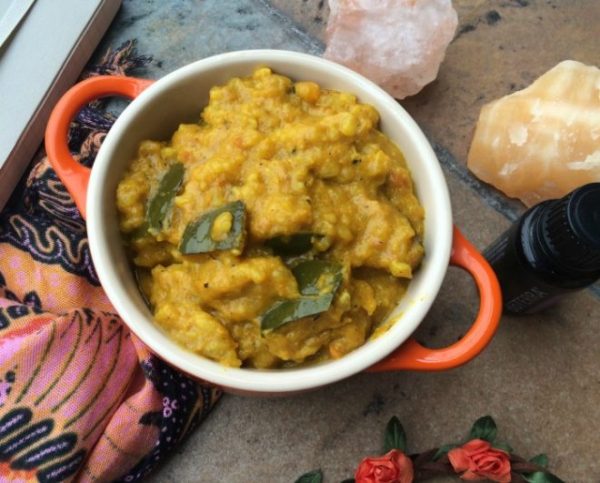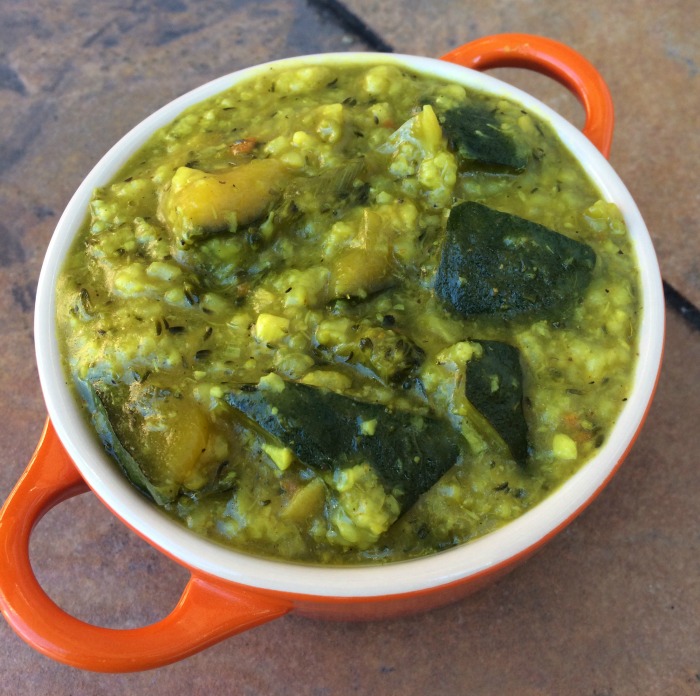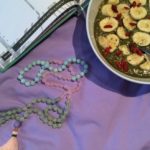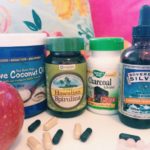Plus a recipe for Kitchari ♥
I’m teaching the nutrition section in a yoga teacher training this month and as I put together the content for this, it’s gotten me thinking a lot about ayurveda and just how much this ancient science shapes how and what I eat.
Ayurveda is basically a system of holistic self-healing – it’s the oldest continually practiced medicine in the world, originating from India over 5,000 years ago. I’ve been very familiar with ayurveda for a long time as a result of working in the yoga world… it’s fairly common to hear us yogis refer to our ayurvedic doshas, how our vata or kapha might be acting up today and so on. Yes, I realise we can sound quite odd to the un-yogafied ear 🙂
What I LOVE about ayurveda is that it’s all about balance – reaching a state of balance in mind-body-spirit in order to be well. It views the world through the lens of 3 different “doshas” or inherent constitutional types. Think of a dosha as sort of your genetic make-up. You are born with a certain “way of being in the world,” a certain physical and mental make-up. This inherent way of being does not change and thus, the dosha that you are born with is your dosha for life.
The 3 doshas are made up of different elements from nature –
Vata – made of air & space
Pitta – made of fire & water
Kapha – made of earth & water
And with these dominant elements comes a certain tendency of being:
Vata
Made up of air and space, the dominant qualities of vata are light, dry, subtle, mobile, cold, and rough. Vata is all about movement.
- The light quality manifests in a body type usually on the thin, lanky, or underweight side.
- The dry and rough qualities manifest as a tendency towards dry skin and hair.
- The mobile quality manifests as often multi-tasking, working fast, rushing around, and always being on the go.
- The subtle quality manifests as being creative and quick-thinking.
- The cold quality manifests as tending to feel cold more easily than others and craving heat and warmth.
- The hot quality manifests as having a warm body temperature, a strong appetite and digestive system.
- The sharp quality manifests as a sharp intellect, mind, and/or temper.
- The oily quality manifests as a tendency towards oily skin or acne.
- The mobile quality manifests as being active and energetic.
- The light quality manifests in a body type tending to be on the slender side.
- The liquid quality manifests as a tendency to sweat easily.
- The smooth and soft qualities manifest as a tendency to have soft, beautiful skin.
- The heavy quality manifests as a grounded presence and mind, with a body type that tends to gain weight more easily.
- The cool quality can manifest as cool-to-the-touch skin and also a very laid-back personality.
- The slow quality manifests as operating with a steady and easy-going pace in life.
- The stable quality manifests as having great stamina, being able to keep calm during crisis and “hold down the fort” for others.
Pitta
Made up of fire and water, the dominant qualities of pitta are hot, sharp, mobile, oily, light and liquid. Pitta is all about transformation – (think of fire and how it radically changes whatever it touches).
Kapha
Made up of earth and water, the dominant qualities of kapha are smooth, soft, heavy, cool, slow, and stable. Kapha is all about steadiness and stability.
Are you beginning to get a sense of which dosha type you might be?
Or maybe you’re a split combination of two.
Ayurveda teaches that whatever dominant dosha we are, means we already have an abundance of those qualities in us. Our work is to bring in steady amounts of OPPOSITE qualities in order to shift ourselves to a state of balance.
There are a million ways to balance doshas – however, food has the greatest impact and is really the #1 place to start. This is all about favoring opposite flavours and tastes of whatever dosha you are (for example, eating popcorn for a vata is imbalancing as this food is extremely light, airy, and dry – all qualities that vata already has in abundance!)
++
My experience with eating for my Dosha
For me, as a total vata (really, I am about as vata as they come!!), I have found that including a lot of vata-balancing foods in my diet (while steering clear of some majorly imbalancing ones) really does give me a great sense of wellbeing. Overall everything just “feels” better – my digestion works best, my moods are stable, I feel warm, nourished and at ease. Vata-balancing foods taste great to me and many of them I often crave which I think is interesting – it’s like my body just naturally gravitates to the foods with soothing, beneficial qualities for me.
Some foods that I tend to eat a lot of as a Vata and feel GREAT eating:
– avocado
– nut butters & nuts, esp cashews
– cashew cream
– bananas
– winter squash
– sweet potatoes
– berries
– sauteed veggies
– mango
– coconut milk, coconut oil
– butter
– spices (I spice many of my meals heavily!)
Note the heavy, dense, oily, creamy, and sweet qualities in most of the above foods. My body thrives off of these qualities as a vata.
I encourage you to try this for yourself and see how it works for you. There are a million different dosha quizzes out there on the internet as well as dosha-specific food lists that you can google. But honestly, I think most of us can look at a food and pinpoint certain qualities about it right off the bat. Is it dense or light? Is it dry or watery? Is it a bit sweet or more bitter? Does it have a sort of drying aftertaste (astringent)?
I’m not a fan of adhering 100% to any set diet out there and I definitely don’t eat vata-only meals. After all, there is so much more to consider beyond dosha type – we are WAY more than just a dosha! But I love using ayurvedic principles as a guideline, helping me to choose foods with qualities that feel supportive.
++
And speaking of supportive eating… I’m sharing one of my favourite ayurvedic recipes today – kitchari!
Kitchari is a simple spiced rice & bean porridge from Indian cooking that has tons of healing benefits. It’s soothing, cleansing and ideal for eating when doing a detox or when you’d like to give your digestive system a little rest. I make this regularly throughout the winter and love that it’s so warming and fabulous for revving up the digestive fire. Curling up in blankets on a cold winter’s night with a bowl of kitchari.. total comfort food and SO incredibly cozy. Here is my version…
(Note that a few ingredients below are not part of a “traditional” kitchari recipe like the garlic, squash, or coconut milk. I add these in just because I like them and they go well. Feel free to adjust however you like).
My version of kitchari – the basic recipe:
1 tbsp of fresh ginger, diced small
1 tbsp of fresh turmeric, diced small (if you don’t have this available in your area, the dried powder is fine)
3 cloves garlic, diced small
1 big tbsp curry powder (I use a mix that contains several different spices)
1 tsp sea salt
1/2 tsp black pepper
1-2 tbsp coconut oil and/or butter or ghee
1/2 cup split yellow mung beans (soaked for 7-12 hrs in warm water + lemon juice)
1 cup chopped kabocha squash
1/3 cup organic white rice
about 6-8 cups filtered water (I choose to sub in coconut milk for part of the water sometimes but all water is fine too)
Option to add in other veggies if you like. I mostly prefer to use just squash but sometimes will add broccoli or kale if I’m feeling it.
*I also want to emphasise to be sure to soak the beans beforehand when you make this recipe – this is a MUST in order to reduce the anti-nutrients present in beans that block mineral absorption. Soaking also makes the beans much more digestible.*
1. Rinse soaked mung beans until water runs clear.
2. In a large pot, add the coconut oil and/or butter, diced ginger, turmeric, garlic, curry powder, sea salt and pepper. Roast on low heat until cooked through (this really enhances the spice flavours).
3. Stir in rice, mung beans and squash, coating them with the spice mixture.
4. Add water and bring to a boil. Then turn heat to low, cover, and cook for 30 – 40 minutes (take a peek after 30 min and adjust remaining cook time as needed. You may need to add more water in as well – aiming for a porridge-like consistency).
5. Once finished, remove from heat and let sit with the cover on for 5-10 minutes.
ENJOY! Kitchari tastes best when you make and eat it fresh. ♥
xx, Diana







